Lazinica A. (ed.) Particle Swarm Optimization
Подождите немного. Документ загружается.

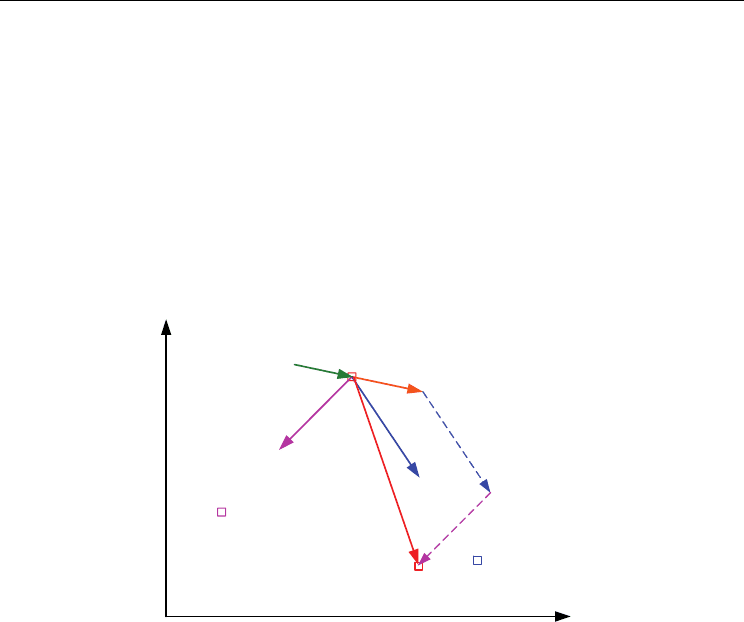
A Novel Binary Coding Particle Swarm Optimization for Feeder Reconfiguration
441
algorithm will check the results every iteration until the best solution is found or
termination conditions are satisfied.
() ()
ididid
new
id
xgbestrandcxpbestrandcwvv −××+−××+= () ()
21
(4)
new
idid
new
id
vxx +=
(5)
In the above equations, v
id
is the original velocity of the i-th particle,
new
id
v is the new
velocity of the i-th particle, w is the inertia weight, c
1
and c
2
are the acceleration constants, x
id
is the original position of the i-th particle,
new
id
x is the new position of the i-th particle and
rand() is a random number ranging between 0 and 1.
x
y
new
id
x
id
x
id
v
pbest
gbest
new
id
v
inertia
social
cognition
Figure 3. Searching diagram of typical PSO
In (4), the first part is the inertia (habitual behavior), which represents the particle trusts its
own status at present location and provides a basic momentum. The second part is the
cognition (self-knowledge) or memory, which represents the particle is attracted by its own
previous best position and moving toward to it. The third part is the social (social
knowledge) or cooperation, which represents the particle is attracted by the best position so
far in population and moving toward to it. There are restrictions among these three parts
and can be used to determine the major performance of the algorithm. The purpose of
updating formula is to lead particles moving toward compound vector of inertia part,
cognition part and social part. By doing so, the opportunity for particle to reach the target
(optimal solution) will be increased. The inertia weight in the formula is used to adjust
searching areas. A larger inertia weight will motivate the algorithm toward a global search;
a smaller value will force the PSO toward a local search. The searching diagram of typical
PSO is shown in Fig. 3.
3.2 Binary Particle Swarm Optimization
Kennedy and Eberhart proposed a binary version of PSO for discrete problems (Eberhart &
Kennedy, 1997). In the binary PSO version, the particle’s personal best and global best is still
updated as in the typical version as described in (4). The elements inside x
id
, pbest and gbest

Particle Swarm Optimization
442
of BPSO are either `1‘ or `0‘. Therefore, a particle flies in a search space restricted to zero
and one. The speed of the particle must be constrained to the interval [0, 1]. A logistic
sigmoid transformation function
)(
new
id
vS shown in (6) can be used to limit the speed of
particle.
new
id
v
new
id
e
)S(v
−
+
=
1
1
(6)
The update equation of BPSO can be done in two steps. First, (4) is used to update the
velocity of the particle and the sigmoid function, (6), is used to limit the velocity in the
interval [0, 1]. Second, the new position of the particle is obtained using (7) shown below:
(
)
1 then x) S(vrand() if
new
id
new
id
=<
0 else x
new
id
=
(7)
where, rand() is a uniform random number in the range [0, 1].
Since the relevant variables are derived from the changes of probabilities, the concept of
BPSO is different from the typical PSO. It is hard to identify the relation between the current
status and previous status of a particle. The selection of parameters, such as inertia weight,
acceleration constants, etc., is also problematic.
3.3 Binary Coding Particle Swarm Optimization
Through the discussion of typical PSO and BPSO in the previous section, the PSO algorithm
cannot be applied to feeder reconfiguration directly. Therefore, this research tries to
construct a more feasible discrete PSO scheme based on the concept of typical PSO for
feeder reconfiguration. The typical PSO must be modified based on the characteristics of
distribution feeder operations. Two issues will be considered in the modification process.
The first one is the problem of feeder reconfiguration is ‘1’ & ‘0’ permutation combinatorial
optimization problem. The second issue is utilizing the shift operator that is used in
computer programming languages. The shift operator and shift operator set defined in this
research using these two aspects. Shift operator and shift operator set can be used to
construct the binary coding particle swarm optimization for distribution feeder
reconfiguration. These two definitions and the proposed binary coding PSO will be
discussed.
3.3.1 Shift Operator
Suppose m sectionalizing switches (normally closed, N.C.) and n tie switches (normally
opened, N.O.) exist on a distribution system. The permutation combination of the status all
switches (s=m+n) is [S
1
, S
2
, …, S
s
] and it will be called ‘sequence of switch states’, or SSS, in the
rest of this paper. The shift operator is defined as SO (Bit
i
, Direction
L,R
, Step
c
) and it means that
an action will change the position of an N.O. in SSS. Bit
i
is the index of i-th switch in SSS.
Direction
L,R
indicates the direction of left or right shifting on the i-th switch. Step
c
is the
number of shifting steps. The new permutation in SSS is defined as SSS’=SSS <+> SO. The
symbol, ‘<+>’, represents the shift operator. It will be applied to SSS to get a new SSS’.
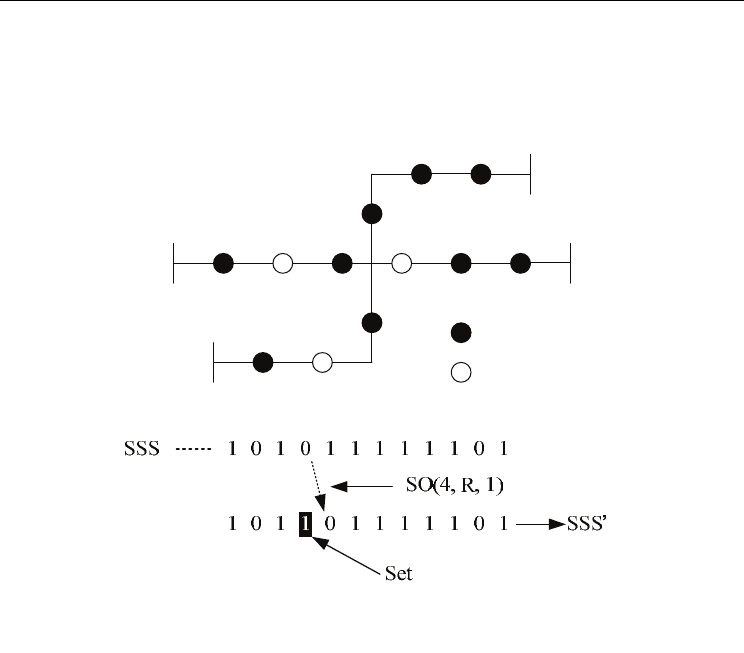
A Novel Binary Coding Particle Swarm Optimization for Feeder Reconfiguration
443
A case is used to explain the operating process of shift operator. A simple distribution
system shown in Fig. 4 has four feeders, nine N.C.s and three N.O.es. The SSS of this system
is denoted as [1 0 1 0 1 1 1 1 1 1 0 1]. Supposing an SO(4, R, 1) is applied on this SSS. The
process of operation is described as Fig. 5. When an N.O. shifts, a ‘1’ (N.C.) needs to be set at
its original position to maintain system structure.
Sectionalizing Switch
Tie Switch
fd
1
fd
2
fd
3
fd
4
S
1
S
2
S
3
S
4
S
6
S
7
S
10
S
11
S
12
S
8
S
9
S
5
Figure 4. A simple 4-feeders distribution system
Figure 5. Basic operating process of shift operator
3.3.2 Shift Operator Set
A set with at least one or more shift operators is called shift operator set (SOS). An SOS
represents all actions about how to set or shift normal open switches on distribution
systems. The definition of shift operator set is shown in (8).
{}
n
SOSOSOSOS ,...,,
21
=
(8)
where n is the number of shift operators.
Considering two SSSes, SSS
1
and SSS
2
, a set of shift operators which transfers SSS
1
to SSS
2
needs to be identified. Two SSSes, SSS
1
=[1 0 1 0 1 1 1 1 1 1 0 1] and SSS
2
=[1 1 1 1 0 1 1 0 1 0 1
1], are used to explain how the shift operators are obtained. By comparing the position of
normally opened switch one by one in these two SSSes, the SOS can be acquired. The
determination of the shift operator set and the result are shown as Fig. 6. In this example,
SOS={ SO
1
, SO
2
, SO
3
}= SSS
2
Θ SSS
1
. The symbol, ‘ Θ ’, is used to represent an action to get
the shift operators from SSS
1
to SSS
2
.
Base on the concept of above process, (pbest - x
id
) and (gbest - x
id
) in (4) can be rewritten as
(pbest
Θ x
id
) and (gbest Θ x
id
) respectively. The x
id
, pbest and gbest represent different
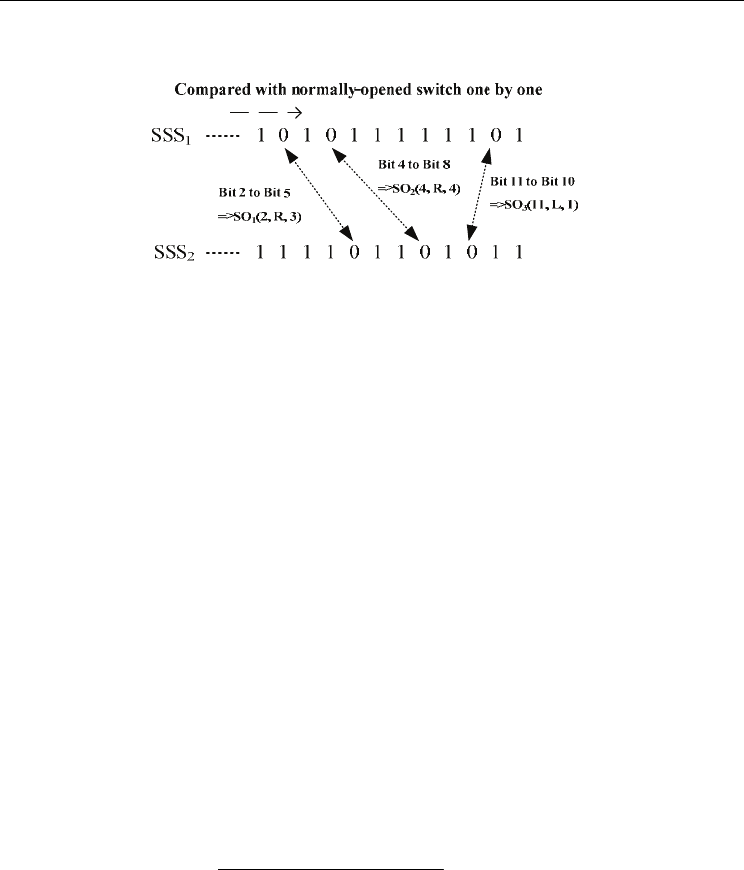
Particle Swarm Optimization
444
SSSes in this sketch. This process will transfer an SSS to a new one which is closer to the best
switch plan.
Figure 6. Decision process of shift operator set
3.3.3 Constructing Binary Coding PSO
The definition of shift operator and shift operator set are discussed in previous sections. The
velocity update formulas (4) and (5) of PSO can be reestablished to solve the problem of
feeder reconfiguration. The new velocity update formula for the proposed binary coding
PSO is as below:
)) (()()) (()()(
ididid
new
id
xgbestrandxpbestrandvwv Θ〈×〉⊕Θ〈×〉⊕⊗=
(9)
new
idid
new
id
vxx 〈+〉=
(10)
The symbol, ‘
⊕ ’, shown in (9) is used for combining two shift operator sets. The symbol,
‘
⊗
’, is the operator that is used to shift the number of steps. The symbol, ‘
〈
×〉 ’, is used to
select the number of shift operator, SO, in (pbest
Θ x
id
) or (gbest Θ x
id
) randomly. x
id
is the
original SSS of the i-th particle; pbest is the best SSS of the i-th particle; gbest is the best SSS
of any particle in the population. v
id
is the original shift operator set of the i-th particle,
new
id
v
is the new shift operator set of the i-th particle.
new
id
x
is the new SSS of the i-th particle.
rand() is a random number with a range of [1, n] where n is the number of SO in SOS.
In Eq. (9), w is the inertia weight. The role of w is used for adjusting searching areas. The
searching areas are reduced progressively when the number of iteration increases. The
inertia weight can be calculated as (11).
max
max
max
ShiftStep
iteration
iterationiteration
w
now
×
−
=
(11)
A simple example is used to show how the proposed method works. Based on the system
shown in Fig. 4, x
id
, pbest and gbest represent different SSSes are given:
x
id
: [1 0 1 0 1 1 1 1 1 1 0 1]
pbest : [1 1 1 1 0 1 1 0 1 0 1 1]
gbest : [1 1 0 1 0 1 1 1 0 1 1 1]

A Novel Binary Coding Particle Swarm Optimization for Feeder Reconfiguration
445
The SOS can be derived from (pbest Θ x
id
) and (gbest Θ x
id
) as:
(pbest Θ x
id
) = {(2, R, 3), (4, R, 4), (11, L, 1)}
(gbest
Θ
x
id
) = {(2, R, 1), (4, R, 1), (11, L, 2)}
The three parts in (9) can be expressed as following:
w
⊗ v
id
= {(2, L, 3), (4, L, 2), (11, R, 2)}
rand()
〈
×〉
(pbest Θ x
id
) = {(2, R, 3), (4, R, 4) , (11, L, 1)}
rand()
〈
×〉 (gbest
Θ
x
id
) = {(2, R, 1), (11, L, 2)}
According to (9), the
new
id
v contains eight SOes, (2, L, 3), (2, R, 3), (2, R, 1), (4, L, 2), (4, R, 4),
(11, R, 2), (11, L, 1) and (11, L, 2). Combining these eight SOes, the final
new
id
v contains three
SOes, (2, R, 1), (4, R, 2) and (11, L, 1). Finally the new SSS,
new
id
x , will be [1 1 0 1 1 0 1 1 1 0 1
1] according to (10).
The procedure of proposed binary coding PSO is outlined as below:
a. Determine the size of population and other parameters such as number of iterations
and maximum shift steps.
b. Initialize the SSS and shift operator sets randomly to produce particles.
c. Evaluate the fitness value for each particle.
d. Compare the present fitness value of i-th particle with its historical best fitness value. If
the present value is better than pbest, update the information including SSS and fitness
value of pbest.
e. Compare present fitness value with the best historical fitness value of any particle in
population. If the present fitness value is better than gbest, update the information
including SSS and fitness value for gbest.
f. Update the shift operator set and generate a new SSS of the particle according to (9) and
(10), respectively.
g. If stop criterion is satisfied then stop, otherwise go to step c). In this research, the stop
criterion is the iteration count reaches the maximum number of iteration.
4. Experimental Results
To verify the performance of the proposed algorithm and compare with algorithms of
typical BPSO (Eberhart & Kennedy, 1997) and modified BPSO (Chang & Lu, 2002) for feeder
reconfiguration problem, a four-feeder distribution system is used. This distribution system
is taken from Taoyuan division, Taiwan Power Company, Taiwan. The system has 24
sectionalizing-switches, 8 tie-switches and 28 load-zones, as shown in Fig. 7. The capacity of
each feeder is shown in Table 1. The objective functions are: minimizing feeder loss and load
balancing index without violating operation constraints. The proposed method and the
algorithms described in (Eberhart & Kennedy, 1997) and (Chang & Lu, 2002) were
implemented using Java language for comparison purposes. Relevant parameters are set as
follows. The size of population is 10 for all methods. Maximum number of iteration is set to
1000 for all methods as well. The inertia weight, learning factor of c
1
and c
2
for the methods
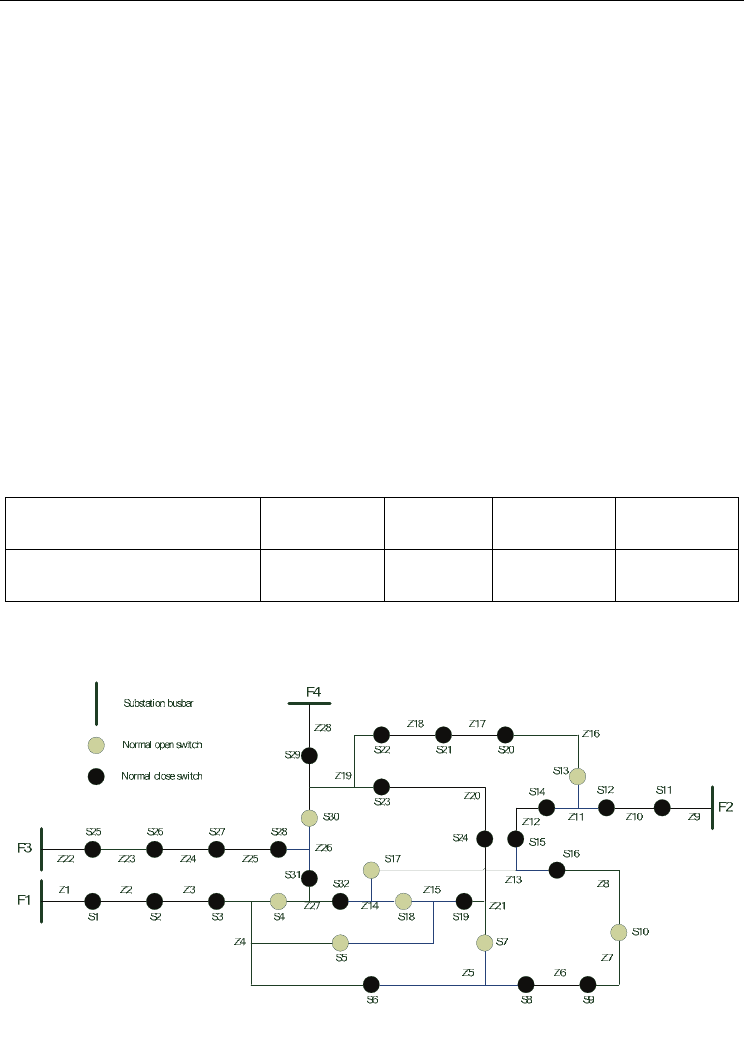
Particle Swarm Optimization
446
of typical BPSO (Eberhart & Kennedy, 1997) and modified BPSO (Chang & Lu, 2002) are set
to 0.8, 2.0 and 2.0, respectively. The settings of these parameters can be referred to (Chang &
Lu, 2002). In order to obtain the results and calculate the average performance, 10 runs were
performed for each method.
The comparisons of the results from the three algorithms are shown in Table 2. The Max,
Min and Average in Table 2 indicate the maximum, minimum and average fitness value,
running time, losses and load balancing index values in 10 runs respectively. The typical
BPSO is not able to get a better result than proposed algorithm due to the higher probability
of inadequate number of tie-switches represented by particles. Although the running time of
typical BPSO is less than proposed method, the average values of losses and load balancing
index of typical BPSO are higher than proposed method. The modified BPSO is able to avoid
the problem of inadequate number of tie-switches represented in each particle. On the other
hand, the result of proposed method is better than other two methods. Beside the execution
time of proposed method is two seconds longer than BPSO, all the other outcomes of
proposed method are superior to other methods. The feeders which represent of maximum
fitness value of feeder reconfiguration of the typical BPSO method, modified BPSO and
proposed method are shown in Fig. 8, Fig. 9 and Fig. 10 respectively. Table 3 lists the
comparison of total loads of each feeder obtained from the three methods. All the results
indicate that the proposed method provides better and more reliable solutions than typical
BPSO and modified BPSO methods for minimizing line losses and load balancing problem.
Feeder ID F1 F2 F3 F4
Capacity (Amp) 500 500 250 500
Table 1. Capacity of each feeder
Figure 7. A 4-feeders distribution system for testing

A Novel Binary Coding Particle Swarm Optimization for Feeder Reconfiguration
447
Method
Typical
BPSO
Modified
BPSO
Binary
coding PSO
Max 0.8759 0.9121 0.9234
Min 0.8058 0.8844 0.8898
Fitness
Value
Average 0.8594 0.8992 0.9032
Max 6625 11015 8734
Min 5250 8812 8110
Running
Time
(msec)
Average 6212 10359 8354
Max 515kW 405kW 364kW
Min 339kW 335kW 312kW
Loss
Average 404kW 365kW 329kW
Max 525928 434216 264648
Min 184712 183368 169112
Load
Balance
Index
Average 329504 294859 208328
Table 2. Results and comparisons of three algorithms
Feeder ID
Method
F1 F2 F3 F4
Original system 176 146 171 203
Typical BPSO 124 312 122 138
Modified BPSO 139 232 122 203
Binary Coding PSO 139 227 110 220
Table 3. The comparison of the feeder loading
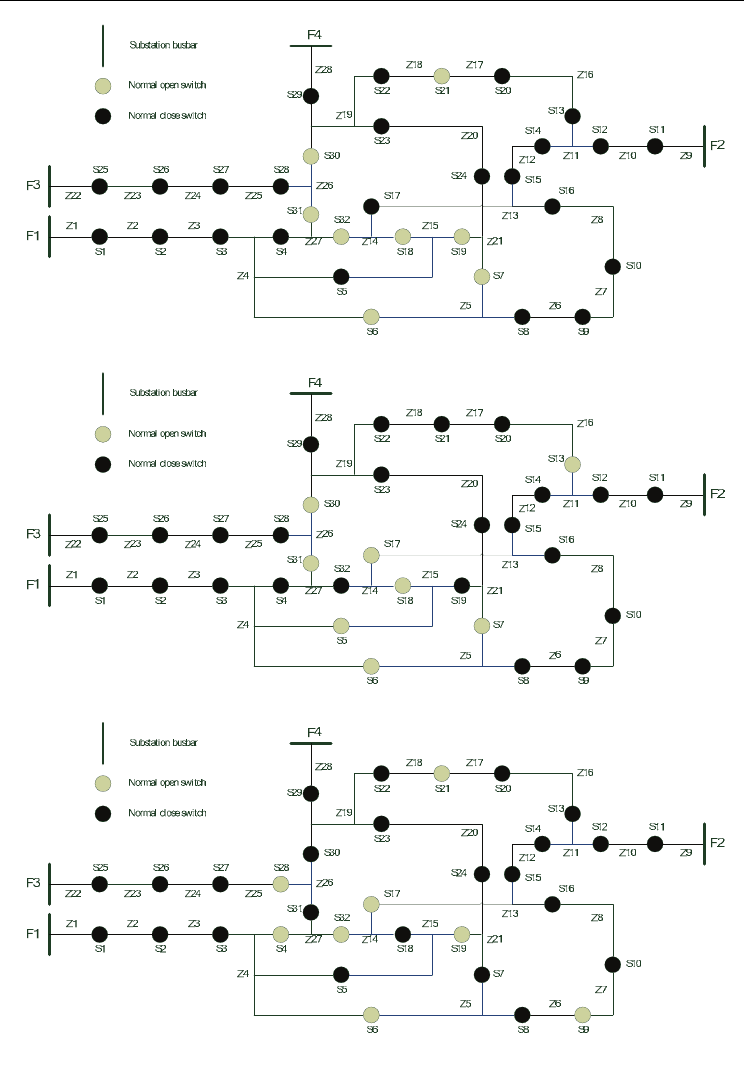
Particle Swarm Optimization
448
Figure 8. The final feeder configuration found by the typical BPSO method
Figure 9. The final feeder configuration found by the modified BPSO method
Figure 10. The final feeder configuration found by the proposed method

A Novel Binary Coding Particle Swarm Optimization for Feeder Reconfiguration
449
5. Conclusion
Particle Swarm Optimization is a novel and powerful algorithm for continuous and discrete
functions optimization problems. In this work, the concept of typical PSO is modified and
applied to the feeder reconfiguration problems. Feeder reconfiguration problems are non-
linear discrete optimization problems in nature; and further, there are some defects to use
typical BPSO directly for feeder reconfiguration. This research try to construct a binary
coding particle swarm optimization based on typical PSO to solve this problem. The
operators of typical PSO algorithm have been reviewed and redefined in this research to fit
the application of distribution feeder reconfiguration. In addition, minimizing total line
losses and load balancing without violating operation constraints are the objective functions
used in this research. The experimental results show that the proposed method can solve the
feeder reconfiguration problem more effectively.
6. Acknowledgement
This research was supported by the National Science Council, Taiwan under contract NSC
97-2221-E-027-110.
7. References
Baran M.E. and Wu F.F. (1989). Network Reconfiguration in Distribution Systems for Loss
Reduction and Load Balancing, IEEE Trans. on Power Delivery, vol. 4, no.2, April
1989, pp. 1401-1407.
Chang H. C. and Kuo C. C. (1994). Network reconfiguration in distribution system using
simulated annealing, Elect. Power Syst. Res, vol. 29, May 1994, pp. 227-238.
Chang R.F. and Lu C.N. (2002). Feeder Reconfiguration for Load Factor Improvement, IEEE
Power Engineering Society Winter Meeting, Vol. 2, 27-31 Jan. 2002, pp.980-984.
Carpaneto E. and Chicco G. (2004). Ant-Colony Search-Based Minimum Losses
Reconfiguration of Distribution Systems, Proc. IEEE Melecon 2004, pp.971-974,
Dubrovnik, Croatia.
Eberhart R.C. and Kennedy J. (1997). A Discrete Binary Version of the Particle Swarm
Algorithm, In Proceedings of IEEE International Conference on Systems, Man, and
Cybernetics, vol. 5, pp.4104-4108, 1997.
Eberhart R.C. and Shi Y. (1998). Comparison between Genetic Algorithms and Particle
Swarm Optimization, The 7th Annual Conference on Evolutionary Programming, San
Diego, USA, 1998.
Hsiao Ying Tung. (2004). Mutiobjective Evolution Programming Method for Feeder
Reconfiguration, IEEE Trans. on Power Systems, Vol. 19, No. 1 pp. 594-599, February
2004.
Hsu Fu-Yuan and Tsai Men-Shen. (2005). A Multi-Objective Evolution Programming
Method for Feeder Reconfiguration of Power Distribution System, Proc. of the 13th
Conf. on Intelligent Systems Application to Power Systems, pp.55-60, November 2005.
Kim H., Ko Y. and Jung K.H. (1993). Artificial Neural Networks Based Feeder
Reconfiguration for Loss Reduction in Distribution Systems, IEEE Trans. on Power
Delivery, vol. 8, no. 3, July 1993, pp. 1356-1366.

Particle Swarm Optimization
450
Kennedy J. and Eberhart R. C. (1995). Particle Swarm Optimization, Proceedings IEEE Int’l.
Conf. on Neural Networks, IV, pp.1942-1948, 1995.
Kitayama M. and Matsumoto K. (1995). An Optimization Method for Distribution System
Configuration Based on Genetic Algorithm, Proceedings of IEE APSCOM, pp. 614-
619, 1995.
Khoa T.Q.D. and Phan B.T.T. (2006). Ant Colony Search based loss minimum for
reconfiguration of distribution systems, 2006 IEEE Power India Conference. Page(s):
6pp, April 2006.
Nara K., Shiose A., Kitagawa M. and Ishihara T. (1992). Implementation of Genetic
Algorithm for Distribution Systems Loss Minimum Reconfiguration, IEEE Trans. on
Power Systems, vol.7, no. 3, August 1992, pp. 1044-1051.
Shi Y. and Eberhart R.C. (1998). A modified particle swarm optimizer, IEEE International
Conference on Evolutionary Programming, pp.69-73, May 1998, Alaska.
Teng Jen-Hao and Lui Yi-Hwa (2003). A Novel ACS-Based Optimum Switch Relocation
Method, IEEE Trans. on Power Systems, vol. 18, no. 1, February 2003, pp.113-120.
